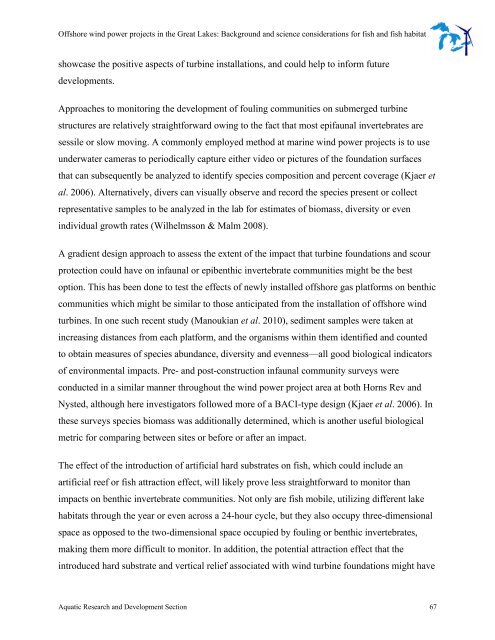Offshore Wind Power Projects in the Great Lakes - Ministry of ...
Offshore Wind Power Projects in the Great Lakes - Ministry of ...
Offshore Wind Power Projects in the Great Lakes - Ministry of ...
You also want an ePaper? Increase the reach of your titles
YUMPU automatically turns print PDFs into web optimized ePapers that Google loves.
<strong>Offshore</strong> w<strong>in</strong>d power projects <strong>in</strong> <strong>the</strong> <strong>Great</strong> <strong>Lakes</strong>: Background and science considerations for fish and fish habitat<br />
showcase <strong>the</strong> positive aspects <strong>of</strong> turb<strong>in</strong>e <strong>in</strong>stallations, and could help to <strong>in</strong>form future<br />
developments.<br />
Approaches to monitor<strong>in</strong>g <strong>the</strong> development <strong>of</strong> foul<strong>in</strong>g communities on submerged turb<strong>in</strong>e<br />
structures are relatively straightforward ow<strong>in</strong>g to <strong>the</strong> fact that most epifaunal <strong>in</strong>vertebrates are<br />
sessile or slow mov<strong>in</strong>g. A commonly employed method at mar<strong>in</strong>e w<strong>in</strong>d power projects is to use<br />
underwater cameras to periodically capture ei<strong>the</strong>r video or pictures <strong>of</strong> <strong>the</strong> foundation surfaces<br />
that can subsequently be analyzed to identify species composition and percent coverage (Kjaer et<br />
al. 2006). Alternatively, divers can visually observe and record <strong>the</strong> species present or collect<br />
representative samples to be analyzed <strong>in</strong> <strong>the</strong> lab for estimates <strong>of</strong> biomass, diversity or even<br />
<strong>in</strong>dividual growth rates (Wilhelmsson & Malm 2008).<br />
A gradient design approach to assess <strong>the</strong> extent <strong>of</strong> <strong>the</strong> impact that turb<strong>in</strong>e foundations and scour<br />
protection could have on <strong>in</strong>faunal or epibenthic <strong>in</strong>vertebrate communities might be <strong>the</strong> best<br />
option. This has been done to test <strong>the</strong> effects <strong>of</strong> newly <strong>in</strong>stalled <strong>of</strong>fshore gas platforms on benthic<br />
communities which might be similar to those anticipated from <strong>the</strong> <strong>in</strong>stallation <strong>of</strong> <strong>of</strong>fshore w<strong>in</strong>d<br />
turb<strong>in</strong>es. In one such recent study (Manoukian et al. 2010), sediment samples were taken at<br />
<strong>in</strong>creas<strong>in</strong>g distances from each platform, and <strong>the</strong> organisms with<strong>in</strong> <strong>the</strong>m identified and counted<br />
to obta<strong>in</strong> measures <strong>of</strong> species abundance, diversity and evenness—all good biological <strong>in</strong>dicators<br />
<strong>of</strong> environmental impacts. Pre- and post-construction <strong>in</strong>faunal community surveys were<br />
conducted <strong>in</strong> a similar manner throughout <strong>the</strong> w<strong>in</strong>d power project area at both Horns Rev and<br />
Nysted, although here <strong>in</strong>vestigators followed more <strong>of</strong> a BACI-type design (Kjaer et al. 2006). In<br />
<strong>the</strong>se surveys species biomass was additionally determ<strong>in</strong>ed, which is ano<strong>the</strong>r useful biological<br />
metric for compar<strong>in</strong>g between sites or before or after an impact.<br />
The effect <strong>of</strong> <strong>the</strong> <strong>in</strong>troduction <strong>of</strong> artificial hard substrates on fish, which could <strong>in</strong>clude an<br />
artificial reef or fish attraction effect, will likely prove less straightforward to monitor than<br />
impacts on benthic <strong>in</strong>vertebrate communities. Not only are fish mobile, utiliz<strong>in</strong>g different lake<br />
habitats through <strong>the</strong> year or even across a 24-hour cycle, but <strong>the</strong>y also occupy three-dimensional<br />
space as opposed to <strong>the</strong> two-dimensional space occupied by foul<strong>in</strong>g or benthic <strong>in</strong>vertebrates,<br />
mak<strong>in</strong>g <strong>the</strong>m more difficult to monitor. In addition, <strong>the</strong> potential attraction effect that <strong>the</strong><br />
<strong>in</strong>troduced hard substrate and vertical relief associated with w<strong>in</strong>d turb<strong>in</strong>e foundations might have<br />
Aquatic Research and Development Section 67
















